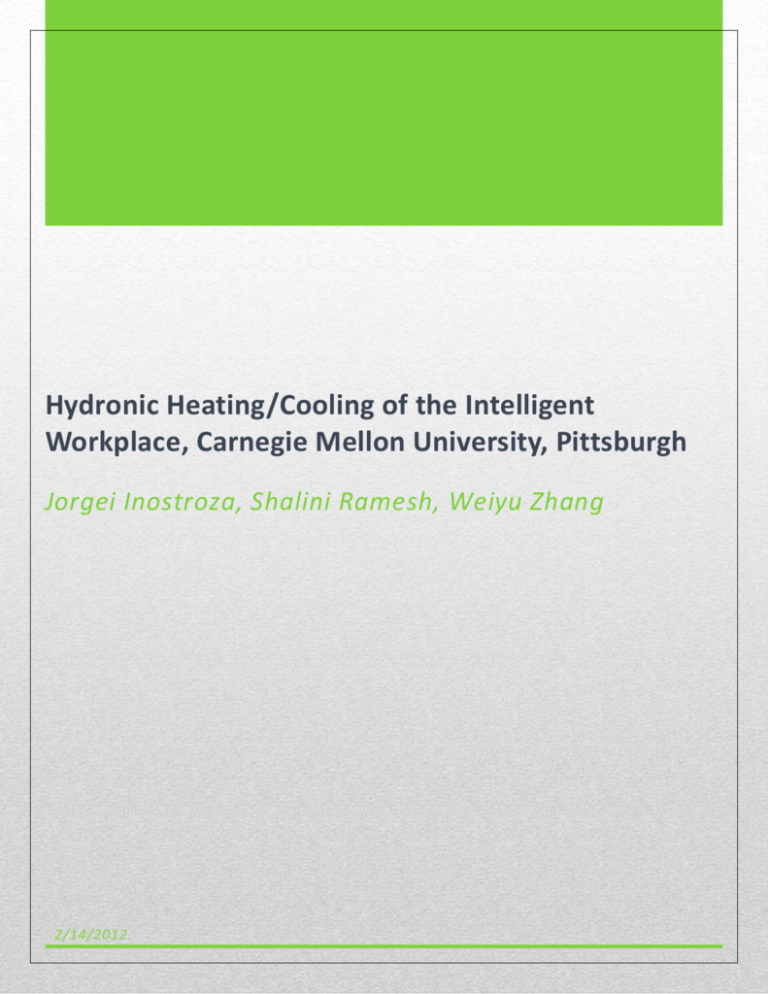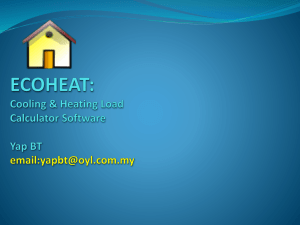Report_02142012 - Andrew.cmu.edu
advertisement

Hydronic Heating/Cooling of the Intelligent Workplace, Carnegie Mellon University, Pittsburgh Jorgei Inostroza, Shalini Ramesh, Weiyu Zhang 2/14/2012 Table of Contents Table of Figures........................................................................................................................................................................................................ 1 Introduction............................................................................................................................................................................................................... 2 Overall HVAC System ............................................................................................................................................................................................. 2 Components of the HVAC System in the basement .............................................................................................................................. 3 Schematic Hot Water System......................................................................................................................................................................... 5 Schematic Chilled Water System.................................................................................................................................................................. 6 Fourth Floor Secondary Water Loop .......................................................................................................................................................... 6 Building Controls for the HVAC System .................................................................................................................................................... 7 Mathematical Model for the HVAC System .............................................................................................................................................. 8 Current Model: ................................................................................................................................................................................................ 8 Previous Model: .............................................................................................................................................................................................. 8 Mullions heating and cooling system .............................................................................................................................................................. 9 Components of the mullion heating/cooling System ........................................................................................................................10 Assembly of Radiant Panels: ........................................................................................................................................................................13 Mathematical model for radiant panels ..................................................................................................................................................14 Components of Radiant panels ...................................................................................................................................................................15 Cool Waves ...............................................................................................................................................................................................................17 Components of Cool waves...........................................................................................................................................................................18 Design of Web – Interface to display system information and components data ......................................................................19 Conclusion ................................................................................................................................................................................................................20 Table of Figures Figure 1: Schematic diagram of the Overall HVAC System .......................................................................................................................... 2 Figure 2: View of the heat exchanger and the supply water pipes in the basement .......................................................................... 3 Figure 3: Schematic diagram of the hot water system ................................................................................................................................. 5 Figure 4: Schematic diagram of the chilled water system ........................................................................................................................... 6 Figure 5: Schematic diagram of the water loop in the 4th floor mechanical room ............................................................................. 6 Figure 6: View of the Siemens controls panel located in the basement ................................................................................................. 7 Figure 7: Plan of the Intelligent Workplace indicating server locations and the areas controlled by the server ...................... 7 Figure 8: Flowchart of the mathematical model currently used for controlling the IW as implemented by Siemens ............ 8 Figure 9: Plan indicating the location of the mullion sets in the IW ......................................................................................................... 9 Figure 10: 3D view of the mullion system indicating various components of the system ..............................................................10 Figure 11: View of the radiant panels in the IW .......................................................................................................................................12 Figure 12: Schematic Diagram of the water pump, flow rate valve for the radiant panels ....................................................12 Figure 13: Plan indicating the location of the radiant panels in the IW .........................................................................................13 Figure 14: View of the water pipes supplying hot/cold water to heat/cool the aluminum panels ....................................14 Introduction The study focuses on the working of the hydronic heating/cooling systems in the Intelligent Workplace, Margaret Morrison Carnegie Hall, Pittsburgh. The main aim was to gain adequate technical information about the system functioning and the controls logic for the system. The study focused on creating a website of all the hydronic systems and linking the (historical) performance data recorded by the sensors to a database using MySQL, Adobe Dreamweaver using PhP platform. The study aimed at creating a web – interface which can be accessed on the internet providing adequate information about the technical specifications of the system components as well as displaying the performance data. Overall HVAC System Figure 1 illustrates the schematic HVAC system which provides for heating and cooling of the Intelligent Workplace on the fourth floor of Margaret Morrison Carnegie Hall (MMCH). The hot water is supplied from the campus steam network into the second basement of MMCH. The campus supplied steam is converted into hot water in the second basement by the heat exchanger which is then pumped onto the 4th floor mechanical room. The hot water in the 2nd basement is 180 F and the supply water in the 4th floor is 178 F. The hot water is pumped from the 2nd basement to the 4th floor mechanical room by the hot water supply pump located in the 2nd basement. There are two hot water supply pumps in order to alternate the usage of the pumps in situations of breakdown or overload of one of the pumps. The chilled water is supplied from the campus chilled water network which is pumped onto the 4th floor. The temperature of the supply water is approximately between 40 F – 42 F. Figure 1: Schematic diagram of the Overall HVAC System Figure 2: View of the heat exchanger and the supply water pipes in the basement Components of the HVAC System in the basement Device type Device ID Manufacturer Model Part Number Installation date Water pump Hot/chilled water supply pump Ball & Gossett (ITT Fluid Technology) 1-1/2BC 1510,1750 R.P.M (1510 7.250 BF_09157) 2072196 (IDN: H79) 05/09/1997 Device description: Pump: 85 GPM; 48FT; 3HP; 208 Volts; 60CY; 3PH; Motor ENCL. ODP; Approximate Weight 200 LBS; Material of construction, Bronze fitted; Motor Frame 182 T Engine: Marton Electronic; CAT NO-H123; Model 4VF1821 TDR 7026 DJ; Serial No.: PH-3TUP-TDR; Motor Frame 182 T Device type Device ID Manufacturer Model Part Number Installation date Water flow rate sensor Hot/chilled water flow rate sensor Onicorn Incorporated F - 1210 101801 03/25/1999 Device description: Dual Turbine Insertion Flow Meter Analog Output; Pipe Size 3; SCHD Copper; Frequency Output Factor 36.58 PPG; Analog Output 4-20mA & 0-10 VDC; Flow Scale0-100 GPM Device type Water Temperature Sensor Device ID HWS/CWS - T Manufacturer Johnson controls Model TE 6300 Series temperature sensor Part Number TE – 6312P - 1 Installation date N/A Location of device on schematic: Device description: Thin film nickel, 0.1% accuracy, 8” well, 1k ohm, temperature sensor Schematic Hot Water System Figure 3: Schematic diagram of the hot water system Schematic Chilled Water System Figure 4: Schematic diagram of the chilled water system Fourth Floor Secondary Water Loop Figure 5: Schematic diagram of the water loop in the 4th floor mechanical room Building Controls for the HVAC System The main control system for the HVAC in the Intelligent Workplace is by Siemens Apogee Server which was installed in March/April 2011. Previous to this, the system was controlled by Johnsons Metasys Server. The figure below shows the Siemens control panel located in the basement: Figure 6: View of the Siemens controls panel located in the basement The mullion heating and cooling controls are managed by the Siemens Apogee Server. The main server is connected to 5 sub-systems which controls the highlighted areas in the Intelligent Workplace (IW). The main EN 1 Server Located in mechanical room sends the control signal to the other systems (EN 2, EN 3, EN 4, EN 5) which is received from the Apogee Server. Hence all the main code for the controls is stored in the EN 1 server. Therefore, if the connection is lost between the Apogee Server and the EN 1 system, the system can still function since the main code is stored in the EN 1 server which sends the control information to the other systems. Figure 7: Plan of the Intelligent Workplace indicating server locations and the areas controlled by the server Mathematical Model for the HVAC System Current Model: Currently, the model used for the control system of the IW is formulated by Siemens. The flow chart below describes the functioning of the model. The model uses the Proportional Integrative Derivative (PID) controller model. In this model, the supply temperatures work towards meeting the set point temperatures for each zone. The difference in the supply temperature and the set point temperatures are treated as the error, and mixing valve helps in eliminating this error by equalizing the supply temperature to the set point temperature. Figure 8: Flowchart of the mathematical model currently used for controlling the IW as implemented by Siemens Previous Model: In the Johnsons control system, the system turns on the basement pump (HWP1 and HWP2) if the average south zone and north zone indoor temperature ((Tsouth +Tnorth)/2) is below the pump set point (60 F) or if the schedule calls for it. The Metasys server also turns on the fourth floor mullion water pump if the average indoor temperature is below the mullion water pump set point (60 F) or if the schedule calls for it. The hot water supply temperature set point is based on the indoor and outdoor temperature, and a comfort weighting factor. The hot water set point equation is: Thws = (38-To)*foA + (72 – (Tsouth + Tnorth)/2) * fIA +120 Thws - Hot water supply temperature set point Tnorth & south – indoor temperature of south/north zones foA & fIA – outside/inside air temperature weighing factors (1) The steam valve modulates to maintain hot water set point temperature at the outlet of the heat exchanger. The three way control valve before the mullion pump continuously modulates to maintain the mullion surface temperature set point. The mullion surface temperature set point is decided by the equation: T mullion-s =((Tsouth +Tnorth)/2 + Thws)/2 T mullion-s - Mullion Surface temperature set-point Mullions heating and cooling system The intelligent Workplace (IW) uses heated/cooled mullions as the heating/cooling source in the winter/summer. The mullions heating and cooling system is based on the German Patent Titled, “Integrated Façade System Gartner”. The advantage of incorporating this system of heating and cooling the space are enhanced comfort level and quiet operation. The hot water produced by the heat exchanger in the basement is circulated between the mullions and the heat exchanger by the water pumps in winter. In summer, the chilled water supplied by the campus loop is circulated between the water mullions and the water pump. There is another 33-gpm mullion pump located on the fourth floor to provide additional pressure to overcome the head loss in the mullion system. There are 26 groups of mullions in the IW. Each group had 4-5 mullions controlled by one control valve and a flow rate meter. The mullion pump currently runs at about 26 gpm (max – 32gpm) during daytime schedule. Figure 9: Plan indicating the location of the mullion sets in the IW Figure 10: 3D view of the mullion system indicating various components of the system Components of the mullion heating/cooling System Device type Device ID Manufacturer Model Part Number Installation date Analog Sensor – 100 𝛀 Thermistor Return water temperature sensor Siemens 1 – ½ inch (3.8 cm) sensor with clamps 540-258 03/2011 – 04/2011 Device description: Temperature range: 35 F – 240 F (-37 C – 116 C) Device type Device ID Manufacturer Model Part Number Installation date Valve By-pass valve Johnson controls M9000-5000 N/A 1997/1998 Device description: Temperature range: 35 F – 240 F (-37 C – 116 C) Device type Device ID Manufacturer Model Part Number Installation date Control valve M X - VLV N/A N/A N/A 1997/1998 Device description: Located below each set of mullions. Radiant Panels Radiant panels in the Intelligent Workplace are used for heating/cooling purposes. Radiant ceilings are continuously suspended ceilings that operate according to the radiation principle. The panels may be either linear or modular with flat, grooved, or channeled surfaces. Linear panels are generally either extruded aluminum or steel heating strips in 1- to 2-ft widths and lengths to approximately 16 ft. The individual panels can be fastened together by brackets or be formed as tongue-and-groove units to form panels of the length and width required. Modular panels utilize similar framing that facilitates recess mounting in gypsum or T-bar grid ceiling systems. The face of the metal panel is the radiating surface to which the heat is conducted from the copper tubing that is routed through heat transfer channels. The tubing is mechanically held in direct contact with the back of the panel plank or trays to facilitate heat conduction. Hot/cold water is circulated into these copper tubes according to the required indoor temperature. In the IW, during winter, the system is turned on during the early morning hours (4am-9am) to meet the indoor set point temperature. Once the indoor temperature is met, the system is turned off. During summer, the panels are used for cooling purposes. The system is turned on when the indoor temperature rises above 65 F. Figure 11: View of the radiant panels in the IW Figure 12: Schematic Diagram of the water pump, flow rate valve for the radiant panels Figure 13: Plan indicating the location of the radiant panels in the IW Assembly of Radiant Panels: The overhead panels in Figure xx are made of two aluminum panel pieces. Two pieces of panels are connected by a Ushaped tube to form one module. One panel is approximately 7ft long, and one module is approximately 14ft long (two panels). Fig 14 shows a detail of the connection of the coil and the aluminum panel on a Trox radiant panel. The pipe is a 0.5 inch nominal diameter copper tube and the width of each panel is about 8 inches. Hot/cold water is circulated in these copper pipes. The pipes are well insulated to avoid temperature loss. Figure 14: View of the water pipes supplying hot/cold water to heat/cool the aluminum panels Mathematical model for radiant panels The process of heat transferring from the radiant panel to the indoor space can be separated into two parts: (1) heat transferred from the root section, shown in equation 2, where the heat flow component is given by 𝑞1̇ as shown in equation 1, and (2) the heat transferred by the fin section,𝑞2̇ , as shown in equation 1. ………………………………………………..…………….equation 1 Ta is the air temperature, Tb is the temperature, Ff is the fin heat transfer coefficient, which can be calculated from the formula specified in equation 2. ………………………………………………………………equation 2 From the above equations, the total heat transfer can be calculated using the equation 3. ………………………………………………………………equation 3 The heat transferred from the water to the radiant panel can be determined using the water-side resistance, the contact resistance and conduction resistance using equation 4. …………………………………………..equation 4 The heat transferred from the radiant panel can be expressed by means of an efficiency factor F1, which is given by the ratio of the overall heat transfer from the fluid and the overall heat transferred to the room from the fins, which is given by equation 5. ……………………………….……………………………………………….equation 5 The factor F1 is determined by equating equation 4 and 5 which is given by the following equation: ……………………………………………………………..equation 6 Components of Radiant panels Device type Device ID Manufacturer Model Part Number Installation date Pump (Cartridge Circulator) Water pump for radiant panels TACO Incorporated 0011 – F4 N/A 1997/1998 Device Description: Bronzy cylinder, Cast Iron, Aluminum Stator Housing, Stainless Steel Cartridge, 5.5 kg Weight 115 Volts, 60 Hz, 1 Ph, 1.76 Amps, 3250 RPM, 1/8 HP Minimum Fluid Temperature: 40F, Maximum Fluid Temperature: 230F Minimum Fluid Temperature: 40F, Maximum Fluid Temperature: 230F Device type Siemens Actuator Device ID Manufacturer Model Part Number Installation date Actuator valve for radiant panels Siemens SSA61U N/A March/April 2011 Device Description: For use in heating systems in conjunction with radiator valves from Landis & Staefa or from other manufacturers. Device type Setra Pressure Transducers Device ID Differential Pressure Transducers for Radiant panels Manufacturer Setra Model 206/207 Part Number N/A Installation date March/April 2011 Device Description: Setra's Model 264 versatile low differential pressure transducer is widely used in the accurate measurement of pressures and flows for proper building pressurization and air flow control. Optional accuracies of ±0.4% FS and ±0.25% FS are available as well as the standard ±1.0% FS accuracy. Pressure ranges as low as ±0.1"WC up to 100"WC are standard, with10 PSI overpressure on all ranges. Cool Waves The IW heating-cooling system includes ten chilled beams LTG cool waves units for cooling in the north side of the building. The LTG cool waves are compact, ceiling mounted units which cools the air by convection by means of a fan, oscillating between two heat exchangers, which generates streams of cool air. The resulting air current decays rapidly, generating a soft, uniform flow of cooling air throughout the room. The lowest water supply temperature for operation without condensation essentially depends on the humidity of the air and may be 1-2 K below the dew point of the ambient air. Components of Cool waves Device type Device ID Manufacturer Model Part Number Installation date Cool wave Unit IW_Coolwave_1 LTG KFA 1000 T/F N/A 1997 Device description: Device size varying between 800-1000mm. Device type Device ID Manufacturer Model Part Number Installation date Cartridge Circulator CP_1 TACO 0011-F4 N/A 1997 Device description: Cast Iron, Flow Range: 0-28 GPM. Head Range: 0-30 ft., Min. Fluid Temp: 40 F (4 C) Max. Fluid Temp: 230 F (110 C) Max Working Pressure: 125 PSI Design of Web – Interface to display system information and components data The main aim of web design is to provide online access to the functioning of the HVAC system in the Intelligent Workplace. The website describes in detail the layout of the system and each component of the system. The website contains 10 pages which provide information about the components used in the mullion, radiant panel and cool waves systems. The page below shows a snap shot of the first page of the website with the various tabs to the other pages. The website is designed to display (historical) performance data for the three systems individually. Every set of mullions, radiant panels and cool waves are linked to a database which gives information on the temperature, pressure for a given time. Data in the database is available for every minute. Currently due to the non-availability of the PHP server to publish the database online, the data is displayed as static data using a pop-up window. The popup window displays temperature information for every heating and cooling system. The website is published on the cmu server for online viewing. Conclusion From this study, the first task accomplished was the study of the functioning of the IW HVAC Systems and the controls and sensors involved in the functioning of the system. The second important task accomplished was the design of a web-interface using sensor database based on the MySQL platform, PHP, and Adobe Dreamweaver CS5. The important result of this assignment was the development of the web-interface which helped us understand the technique to display data in an informative manner to the consumer. Although the data displayed for this assignment was static data, it has helped us understand the semantics behind this and help us investigate further to accomplish the data display for future work. From the study of the HVAC system, it was observed that, apart from the supply water temperature sensor in the basement and the fourth floor mechanical room, there are no other sensors to measure the temperature of the supply water into the mullions, radiant panels or the cool waves. Secondly, the IW has only one air temperature sensor in the north. The south side of the building does not have any air temperature sensor and functions on the sensor data obtained from the north sensor. Due to this, sometimes the north side tends to warmer than south end which hinders the performance of the heating and the cooling systems.







